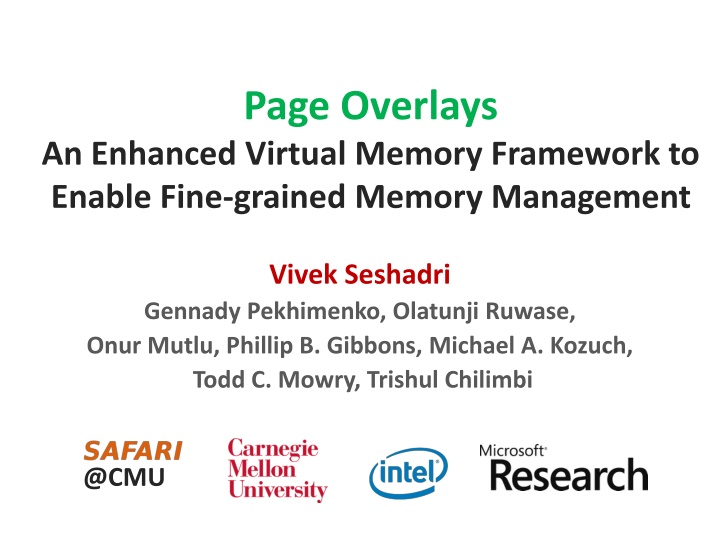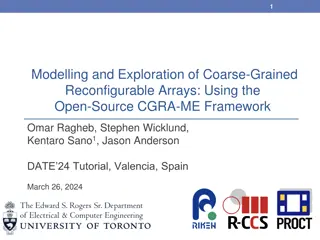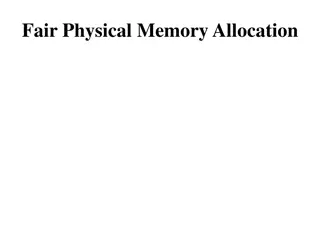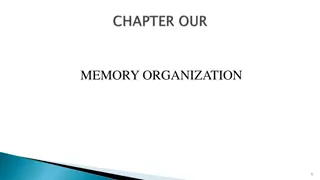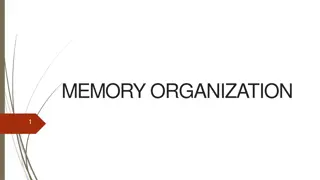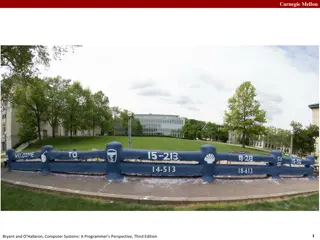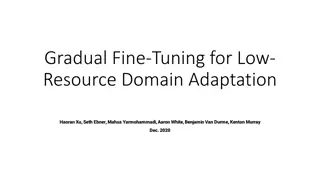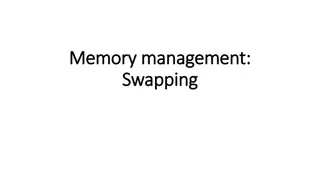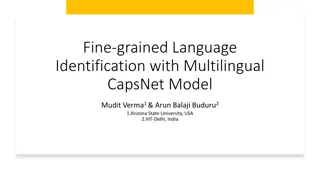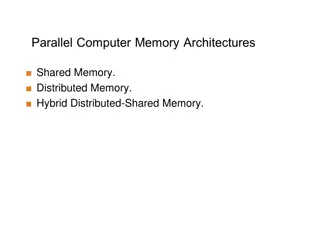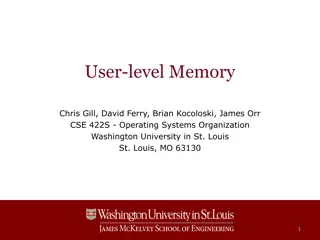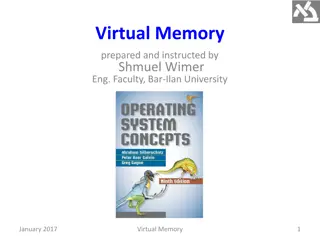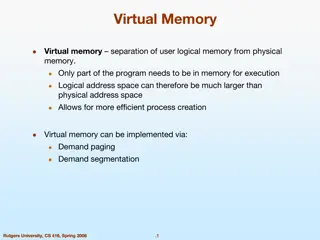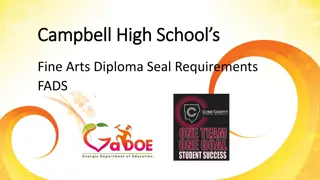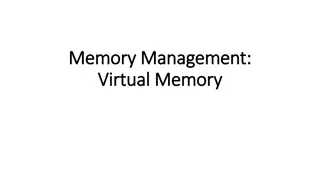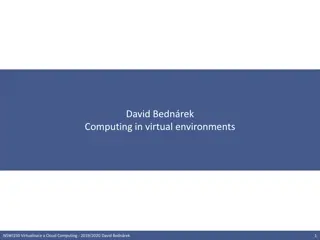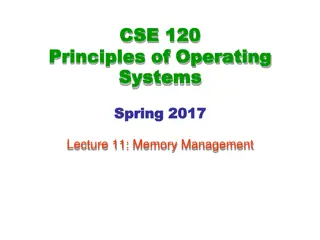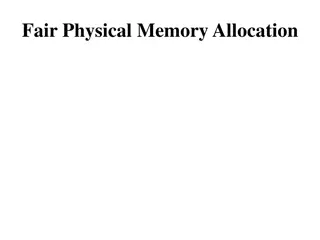Enhanced Virtual Memory Framework for Fine-grained Memory Management
This study introduces Page Overlays, a new virtual memory framework designed to enable fine-grained memory management. By efficiently storing pages with similar data and providing powerful access semantics, Page Overlays improve performance and reduce memory redundancy compared to existing virtual memory systems. The framework retains the existing virtual memory structure while offering low-cost implementation and supporting various applications such as overlay-on-write and sparse data structure representation.
Download Presentation

Please find below an Image/Link to download the presentation.
The content on the website is provided AS IS for your information and personal use only. It may not be sold, licensed, or shared on other websites without obtaining consent from the author.If you encounter any issues during the download, it is possible that the publisher has removed the file from their server.
You are allowed to download the files provided on this website for personal or commercial use, subject to the condition that they are used lawfully. All files are the property of their respective owners.
The content on the website is provided AS IS for your information and personal use only. It may not be sold, licensed, or shared on other websites without obtaining consent from the author.
E N D
Presentation Transcript
Page Overlays An Enhanced Virtual Memory Framework to Enable Fine-grained Memory Management Vivek Seshadri Gennady Pekhimenko, Olatunji Ruwase, Onur Mutlu, Phillip B. Gibbons, Michael A. Kozuch, Todd C. Mowry, Trishul Chilimbi @CMU
Executive Summary Sub-page memory management has several applications More efficient capacity management, protection, metadata, Page-granularity virtual memory inefficient implementations Low performance and high memory redundancy Page Overlays: New Virtual Memory Framework Virtual Page (physical page, overlay) Overlay contains new versions of subset of cache lines Efficiently store pages with mostly similar data Largely retains existing virtual memory structure Low cost implementation over existing frameworks Powerful access semantics Enables many applications E.g., overlay-on-write, efficient sparse data structure representation Improves performance and reduces memory redundancy P V O 2
Existing Virtual Memory Systems Virtual memory enables many OS functionalities Flexible capacity management Inter-process data protection, sharing Copy-on-write, page flipping Page Tables Virtual page Physical Page 4KB 4KB 3
Case Study: Copy-on-Write Page Tables Virtual Address Space Physical Address Space Virtual page Physical Page Copy entire page 2 Copy-on- Write Copy Write Change mapping 1Allocate new page 3 4
Shortcomings of Page-granularity Management Page Tables Virtual Address Space Physical Address Space Virtual page Physical Page Copy entire page 2 Copy-on- Write High memory redundancy Copy Write Change mapping 1Allocate new page 3 5
Shortcomings of Page-granularity Management Page Tables Virtual Address Space Physical Address Space Virtual page Physical Page Copy entire page 2 Copy-on- Write 4KB copy: High Latency Copy Write Change mapping 1Allocate new page 3 6
Shortcomings of Page-granularity Management Page Tables Virtual Address Space Physical Address Space Virtual page Physical Page Copy entire page 2 TLB Shootdown High Latency Copy-on- Write Copy Write Change mapping 1Allocate new page 3 7
Fine-grained Memory Management Fine-grained data protection (simpler programs) Higher Performance (e.g., more efficient copy-on-write) Fine-grained Memory Management Fine-grained metadata management (better security, efficient software debugging) More efficient capacity management (avoid internal fragmentation, deduplication) 8
Goal: Efficient Fine-grained Memory Management Existing Virtual Memory Framework Low performance High memory redundancy New Virtual Memory Framework Enable efficient fine-grained management P V Low implementation cost O 9
Outline Shortcomings of Existing Framework Page Overlays Overview Implementation Challenges and solutions Applications and Evaluation Conclusion 10
The Page Overlay Framework Physical Page C0 C1 C2 C3 C4 C5 The overlay contains only a subset of cache lines from the virtual page C1 Virtual Page C0 C1 C2 C3 C4 C5 C5 C1 Access Semantics: Only cache lines not present in the overlay are accessed from the physical page Overlay C2 C5 C5 11
Overlay-on-Write: An Efficient Copy-on-Write Page Tables Virtual Address Space Physical Address Space Virtual page Physical Page Overlay contains only modified cache lines Copy-on- Write Overlay Write Does not require full page copy 12
Outline Shortcomings of Existing Framework Page Overlays Overview Implementation Challenges and solutions Applications and Evaluation Conclusion 13
Implementation Overview Virtual Main Memory Address Space Regular Physical Pages P V O Overlays Three challenges 14
Implementation Challenges Physical Page Virtual Page C0 C1 C2 C3 C4 C5 C0 C1 C2 C3 C4 C5 C5 3How to keep the TLBs coherent? C3 ? Overlay C2 C5 C5 1Does the cache line belong to the overlay? 2What is the address/tag of the overlay cache line? 15
Identifying Overlay Cache Lines: Overlay Bit Vector Physical Page Virtual Page C0 C1 C2 C3 C4 C5 C0 C1 C2 C3 C4 C5 C5 Indicates which cache lines belong to the overlay ? Overlay C2 C5 C5 1Does the cache line belong to the overlay? Overlay Bit Vector 0 0 1 0 0 1 16
Addressing Overlay Cache Lines: Nave Approach Virtual Use the location of the overlay in main memory to tag overlay cache lines Main Memory Address Space P V O 1. Processor must compute the address 2. Does not work with virtually-indexed caches 3. Complicates overlay cache line insertion 17
Addressing Overlay Cache Lines: Dual Address Design Physical Address Space Virtual Main Memory Address Space P P V O O same size Unused physical address space address space Overlay cache 18
Virtual-to-Overlay Mappings Physical Address Space Virtual Main Memory Address Space Overlay Mapping Table (OMT) (maintained by memory controller) P P V O O Overlay cache address space Direct Mapping 19
Keeping TLBs Coherent Physical Page Virtual Page C0 C1 C2 C3 C4 C5 C0 C1 C2 C3 C4 C5 C5 3How to keep the TLBs coherent? C3 Overlay C2 C5 C5 Use the cache coherence protocol to keep TLBs coherent! 20
Final Implementation Overlay Bit Vectors 3 1 OMT 2 TLB Overlays OMT Cache Last Level Cache Regular Physical Pages L1 Memory Controller CPU Cache 21
Other Details in the Paper Virtual-to-overlay mapping TLB and cache coherence OMT management (by the memory controller) Hardware cost 94.5 KB of storage OS Support 22
Outline Shortcomings of existing frameworks Page Overlays Overview Implementation Challenges and solutions Applications and Evaluation Conclusion 23
Methodology Memsim memory system simulator [Seshadri+ PACT 2012] 2.67 GHz, single core, out-of-order, 64 entry instruction window 64-entry L1 TLB, 1024-entry L2 TLB 64KB L1 cache, 512KB L2 cache, 2MB L3 cache Multi-entry Stream Prefetcher [Srinath+ HPCA 2007] Open row, FR-FCFS, 64 entry write buffer, drain when full 64-entry OMT cache DDR3 1066 MHz, 1 channel, 1 rank, 8 banks 24
Overlay-on-Write Overlay-on-Write Copy-on-Write Virtual page Physical Page Virtual page Physical Page 2 Copy-on- Write Copy-on- Write Overlay Write Write 3 1 Lower memory redundancy Lower latency 25
Fork Benchmark write Copy-on-Write Parent Process 300 million insts Overlay-on-Write Time Fork (child idles) Applications from SPEC CPU 2006 (varying write working sets) Additional memory consumption Performance (cycles per instruction) 26
Overlay-on-Write vs. Copy-on-Write on Fork Overlay-on-Write Copy-on-Write 60 8 7 50 6 Additional Memory (MBs) Cycles per Instruction 40 5 30 4 53% 15% 3 20 2 10 1 0 0 Small DenseSparse Mean Write Working Set Small DenseSparse Mean Write Working Set 27
Conclusion Sub-page memory management has several applications More efficient capacity management, protection, metadata, Page-granularity virtual memory inefficient implementations Low performance and high memory redundancy Page Overlays: New Virtual Memory Framework Virtual Page (physical page, overlay) Overlay contains new versions of subset of cache lines Efficiently store pages with mostly similar data Largely retains existing virtual memory structure Low cost implementation over existing frameworks Powerful access semantics Enables many applications E.g., overlay-on-write, efficient sparse data structure representation Improves performance and reduces memory redundancy P V O 28
Page Overlays An Enhanced Virtual Memory Framework to Enable Fine-grained Memory Management Vivek Seshadri Gennady Pekhimenko, Olatunji Ruwase, Onur Mutlu, Phillip B. Gibbons, Michael A. Kozuch, Todd C. Mowry, Trishul Chilimbi @CMU
